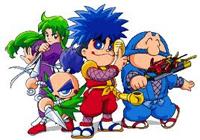Ganbare Goemon: Toukai Douchuu (Nintendo DS) Review
By Rudy Lavaux  12.07.2011
12.07.2011

If the name Ganbare Goemon doesn't ring any bells, then either you know it by its Western name or you're too young to have experienced the few episodes that Konami saw fit to localise during the 90s. Known in Europe as the Mystical Ninja series, the franchise is well-known in Japan and has spawned over 30 games since its inception in the mid-80s, including remakes and spin-offs. Additionally, its characters have made cameo appearances in several other Konami games. Over half of these games were made for Nintendo consoles and yet only five were ever released in the West, the last ones being Mystical Ninja 2 Starring Goemon for Nintendo 64 in 1999, the other being the simply titled Mystical Ninja for Game Boy Color, a coloured upgrade of an older 1991 monochrome Game Boy title and part of the Konami GB Collection Vol. 3 compilation released in 2000. Goemon, the main character of the series, last appeared in the West in Konami Krazy Racers, quite a good, wacky Mario Kart clone for Game Boy Advance released in 2001, marking the debut of the kart racer genre on the handheld a few months before Nintendo's own Mario Kart: Super Circuit. Despite being off the radar for so long in Europe, we look back on the most recent original main entry in the Ganbare Goemon series, which was released for the Nintendo DS in Japan during its first year on the market, way back in June 2005.
Ganbare Goemon: Toukai Douchuu Ooedo Tengurigaeshi no Maki opens with the two main characters, Goemon and his long time sidekick Ebisumaru (weirdly dubbed Kid Ying and Dr. Yang in Legend of the Mystical Ninja for Super NES, but called by their Japanese names in all subsequent Western releases). They're enjoying their own peaceful life in their hometown, Hagure, until the town guards bust into their home, seize them, and throw them in prison under the assumption that they're thieves. As it turns out, the real culprits are a trio of imposters disguised as our two heroes and their friend Sasuke the mechanical ninja. Another pal of theirs, the female ninja spy Yae, comes to their rescue and helps them make a jailbreak, knowing that her two friends would not resort to stealing. Thus begins their journey towards the Eastern Sea (the title’s Toukai Douchuu) to chase after the bad guys. However, along the way they soon discover a bigger foe: Tengu Beruri, a Yôkai dressed like some old British vessel captain wearing a Tengu mask. He threatens all of Japan, and Princess Yuki's life is in danger for the umpteenth time in the series.
All this is presented with a lot of humour, a staple of the series, and with unrealistic visuals, returning to the super deformed style that made it famous in Japan after a couple episodes spent trying new visual styles that did not sit well with fans. Every main entry in the Ganbare Goemon series takes place in medieval Japan, and this one follows the same recipe. Fans of Okami’s settings are sure to enjoy the environments in this game, since the visuals use a similar sumi-e painting style, albeit in a 2D pre-rendered fashion. Ganbare Goemon: Toukai Douchuu actually predates Okami in that respect and, even to this day, the backgrounds are among the most highly detailed found on Nintendo DS.
The low-polygon 3D character models, however, show their age. Their cel-shaded and rather blocky look isn't very appealing, making for a poor in-game representation of the characters' art compared to the very expressive 2D sprites of the SNES installments. It raises questions on whether that style wouldn't have been a better choice, but this might have been considered a poor technical effort considering that the DS marked the true debut of 3D graphics on Nintendo handhelds. An isometric 3D viewpoint is used in most locations, top-down in others and even side-scrolling in some specific locations, making platforming as intuitive as the visual style permits. Multiple views depending on location isn't a first in the series, so this is hardly surprising.
Mixing adventure, platforming and action, this episode of Ganbare Goemon is divided into chapters that correspond to new areas as the team journeys through Japan. In each there's typically a problem to solve, either for the inhabitants or one of their friends. It’s a necessity to talk to people to learn more about what's going on to, which requires an understanding of Japanese - or, at the very least, an online guide. These lead into mini-games or further exploration to discover new skills, each unique to one character, that will help them progress in their journey. Chapters end when the problem is solved, which usually involves defeating a boss in a short dungeon. This is not quite like a Zelda game though; dungeons in this Ganbare Goemon title are either presented in an isometric perspective with very minor puzzling, or use the side-scrolling view to provide some pure platforming. Between each chapter, a Kōdan storyteller comes onto a scene to sum up the adventures of the heroes (in fully voice acted sequences), as if the whole story makes up historical fact. Again, nonsense is a major part of the series.
There are four playable heroes in total. Goemon fights with a Kiseru, Ebisumaru carries a Japanese brochette (!), while Sasuke the mechanical ninja battles with Kunai and Yae the female spy has a katana. Enemies are fought in real time, 2D Zelda style. Goemon and Ebisumaru are available from start and the others join the team as their travels continue. Their skill sets are unique, and a simple button press at any time switches from one character to the other. Each also has a transformation ability at their disposal; for example, Ebisumaru can wear a ballet tutu and carry out a...flatulent dance (no kidding). Yae, on the other hand, instead of transforming into a mermaid, as in previous episodes where this was needed to progress in flooded areas, wears a silly ugly fish suit to allow her to swim.
The basic button controls work superbly, and some actions require the use of the touch-screen, such as flipping an enemy over to reveal its weak point, or flinging the rope the character is standing on to send him flying in the air. The touch-screen is also used in the several mini-games found throughout. Most of them play well, but some problems can arise in specific cases. One such game involves drawing a kanji symbol as in a typical Japanese calligraphy lesson. Indeed, there's a specific order in which the lines have to be drawn in Japanese writing, and the game not only won't accept an incorrect order, but the strokes of the stylus also need to be spot-on. That's not so much of a problem if you went to school in Japan, as this is an exercise that most Japanese children learn in elementary school, but it can be really troublesome for Westerners. Worse, however, is the clay pottery mini-game, wherein a pot must be turned to give it a specific shape. Maybe the potter gives you hints on how to succeed at this in Japanese, but this wouldn't be necessary if the mini-game itself was more intuitive.
Those may be only two mini-games in the whole adventure, but since succeeding at those is required to advance and beat the game, it's an unnecessary source of frustration and the only real bad aspect in the game. Again, thankfully, online guides come in handy to give tips and tricks you can use to succeed easily, and the rest of the game is loads of fun.
There are just a few side quests for the heroes to take on, mainly looking for life bar and money pouch upgrades, as well as hidden elephant statues scattered throughout the game. There's also an unlockable game, the Konami classic Quarth, for the player to unlock. Owners of the Game Boy Advance game Ganbare Goemon 1+2: Yuki-hime to Magginesu (a compilation of the first two Super Famicom games, exclusive to Japan) who have the game in a capable DS’ secondary slot can also unlock more bonuses in the game. Non-playable characters from the Super Famicom Ganbare Goemon games make cameo appearances at different locations throughout the game, and the first level of MSX space shooter Space Manbow becomes accessible.
The Ganbare Goemon series has always been revered for its absolutely amazing soundtracks, mixing classic Asian instruments like shamisen and taiko drums with more modern instruments and beats. This game follows the same rule, and despite the sound quality not being on par with the excellence of the Nintendo 64 episodes, the tracks still sound really good on the DS. The only slight disappointment comes from the lack of a main vocal theme - the N64 games included them despite the lower storage capacity of the home console’s cartridges. The usual big names of the Japanese animé industry that gave their voices to the Ganbare Goemon characters come back to take their roles again as seiyuu. The sequences between chapters are the only fully dubbed ones, leaving only a few yells and catchphrases to accompany the action otherwise.
Cubed3 Rating
Great - Silver Award

It's a real shame that its very Japanese nonsensical humour, as well as the masses of cultural references that Westerners might not understand, prevented most of the Ganbare Goemon series from coming out of Japan. The whole series puts a great emphasis on hilarious situations, anachronisms (an old man playing the Super Famicom in medieval Japan?!) and is a breath of fresh air in the midst of a video game industry that shifts more and more to realistic and serious topics as the machines' capabilities of rendering reality increase. If you can read Japanese and like the genre, get this game if you can. Otherwise, if following a game guide is up your alley and you're looking for something a bit different, then you could very well enjoy this game. Ganbare Goemon: Toukai Douchuu Ooedo Tengurigaeshi no Maki might not be the best game available in the vast library the DS has gathered together in the last six years, but its few flaws can be ignored for what is certainly a good, fun experience.
Comments
Comments are currently disabled

 Sign In
Sign In Game Details
Game Details
 None
None  None
None  Out now
Out now  None
None  Subscribe to this topic
Subscribe to this topic Features
Features





 Top
Top

